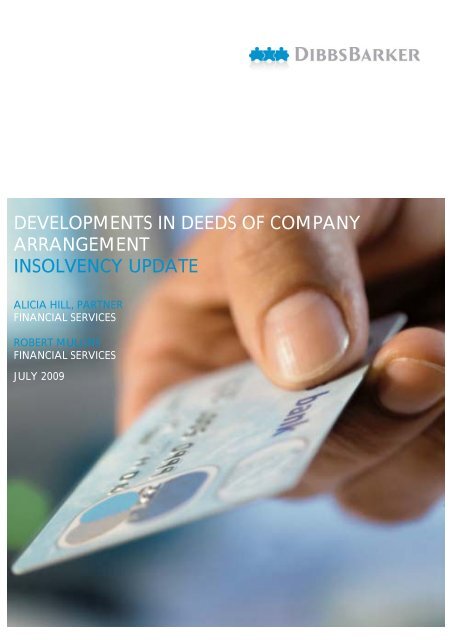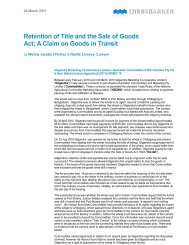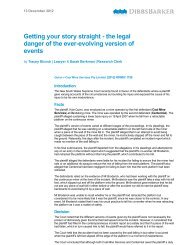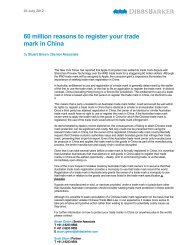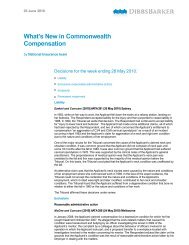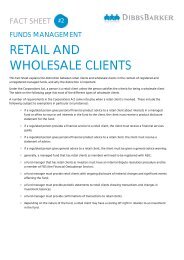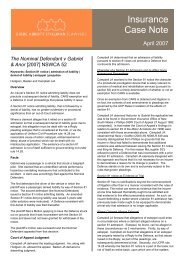developments in deeds of company arrangement - DibbsBarker
developments in deeds of company arrangement - DibbsBarker
developments in deeds of company arrangement - DibbsBarker
You also want an ePaper? Increase the reach of your titles
YUMPU automatically turns print PDFs into web optimized ePapers that Google loves.
DEVELOPMENTS IN DEEDS OF COMPANYARRANGEMENTINSOLVENCY UPDATEALICIA HILL, PARTNERFINANCIAL SERVICESROBERT MULLINSFINANCIAL SERVICESJULY 200911899717 v1 Brisbane 05 08 091
TABLE OF CONTENTS1. INTRODUCTION........................................................................................................32. DEVELOPMENT OF DOCAS.....................................................................................33. RECENT CASES RELATED TO INTERPRETATION AND IMPLEMENTATION OFDOCAS ......................................................................................................................53.1 Priorities and the “pari passu” rule.................................................................53.2 Creditors’ vot<strong>in</strong>g rights...................................................................................83.3 Liquidation as an event term<strong>in</strong>at<strong>in</strong>g a DOCA...............................................114. RECENT CASES RELATING TO COURT INTERVENTION ...................................144.1 Refusal to term<strong>in</strong>ate ab <strong>in</strong>itio .......................................................................144.2 W<strong>in</strong>d<strong>in</strong>g-up <strong>in</strong> the best <strong>in</strong>terests <strong>of</strong> creditors........................................164.3 Opt<strong>in</strong>g for a DOCA <strong>in</strong>stead <strong>of</strong> w<strong>in</strong>d<strong>in</strong>g up....................................................195. CONCLUSION .........................................................................................................2111899717 v1 Brisbane 05 08 092
DEVELOPMENTS IN DEEDS OF COMPANY ARRANGEMENT1. IntroductionThe purpose <strong>of</strong> this paper is to provide an update on the current treatment <strong>of</strong> issuesrelat<strong>in</strong>g to the use <strong>of</strong> Deeds <strong>of</strong> Company Arrangement (DOCAs) under the externaladm<strong>in</strong>istration regime <strong>in</strong> Australia. We beg<strong>in</strong> with a recap <strong>of</strong> the background anddevelopment <strong>of</strong> DOCAs <strong>in</strong> Australia and then exam<strong>in</strong>e recent case law <strong>in</strong>volv<strong>in</strong>g<strong>developments</strong> <strong>in</strong> judicial <strong>in</strong>terpretation and implementation <strong>of</strong> DOCAs and court<strong>in</strong>tervention <strong>in</strong> the DOCAs procedure.2. Development <strong>of</strong> DOCAsVoluntary adm<strong>in</strong>istration <strong>in</strong> the form <strong>of</strong> DOCA’s was <strong>in</strong>troduced <strong>in</strong>to Australian law byvirtue <strong>of</strong> Commonwealth legislation passed <strong>in</strong> 1993, and exist <strong>in</strong> its current form as Part5.3A <strong>of</strong> the Corporations Act 2001 (Cth) (Corporations Act). 1DOCAs were <strong>in</strong>troduced <strong>in</strong> response to recommendations made by the Australian LawReform Commission <strong>in</strong> the Harmer Report. 2The Harmer Report recommended the<strong>in</strong>troduction <strong>of</strong> the DOCA procedure as a method <strong>of</strong> provid<strong>in</strong>g a flexible, swift,uncomplicated and <strong>in</strong>expensive form <strong>of</strong> adm<strong>in</strong>ister<strong>in</strong>g a <strong>company</strong>’s affairs prior to any1 For a further detailed consideration see Corporate Law Reform Act 1992 (Cth); C Anderson, DMorrison, “Should directors be pursued for <strong>in</strong>solvent trad<strong>in</strong>g where a <strong>company</strong> has entered <strong>in</strong>to a Deed<strong>of</strong> Company Arrangement?” (2005) 13 Insolvency Law Journal 163, 163-164.2 Australian Law Reform Commission, Report No. 45, General Insolvency Inquiry (1988) ALRC 45.11899717 v1 Brisbane 05 08 093
prospective w<strong>in</strong>d<strong>in</strong>g up. 3 DOCAs are designed to enable a <strong>company</strong>, through prudentadm<strong>in</strong>istration <strong>of</strong> its affairs <strong>in</strong> coord<strong>in</strong>ation with creditors, to return itself to solvency. 4A “Stocktake” report issued by the Jo<strong>in</strong>t Parliamentary Committee on Corporations andF<strong>in</strong>ancial Services (Jo<strong>in</strong>t Committee) <strong>in</strong> 2004 reported that Deeds <strong>of</strong> CompanyArrangement represented around 40.5% <strong>of</strong> appo<strong>in</strong>tments <strong>of</strong> <strong>in</strong>solvency adm<strong>in</strong>istrations. 5Views on the success <strong>of</strong> the DOCA as a form <strong>of</strong> voluntary adm<strong>in</strong>istration have beenmixed. 6 The Jo<strong>in</strong>t Committee’s 2004 report highlighted a number <strong>of</strong> concerns over thefunction <strong>of</strong> DOCAs through attempts to oppress the <strong>in</strong>terest <strong>of</strong> unsecured creditors andbolster the <strong>in</strong>terests <strong>of</strong> selected stakeholders. 7 Changes have been made to the legislativeframework over the years to reflect some <strong>of</strong> these concerns. 8The current status <strong>of</strong> DOCAs is best summarised by McColl:“While DOCAs are a speedy, efficient, and <strong>of</strong>ten fair method <strong>of</strong> resolv<strong>in</strong>g solvencyissues and re<strong>in</strong>stat<strong>in</strong>g companies as a go<strong>in</strong>g concern, they br<strong>in</strong>g with them the3 Ibid [54].4 Ibid [59].5Parliamentary Jo<strong>in</strong>t Committee on Corporations and F<strong>in</strong>ancial Services, CorporateInsolvency Laws: A Stocktake (Commonwealth <strong>of</strong> Australia Senate Pr<strong>in</strong>t<strong>in</strong>g Unit, ParliamentHouse, Canberra, 2004).6 See C Anderson, D Morrison, supra n 1.7 For an example <strong>of</strong> the concern over the use <strong>of</strong> the DOCA as an <strong>in</strong>strument <strong>of</strong> oppression see MHughes, “Oppression, prejudice and discrim<strong>in</strong>ation under <strong>deeds</strong> <strong>of</strong> <strong>company</strong> <strong>arrangement</strong>” (2000) 11Journal <strong>of</strong> Bank<strong>in</strong>g and F<strong>in</strong>ance Law and Practice 124. See also Parliamentary Jo<strong>in</strong>t Committee onCorporations and F<strong>in</strong>ancial Services, Corporate Insolvency Laws: A Stocktake, ibid [5.21-5.25].8 See changes <strong>in</strong>troduced <strong>in</strong>to DOCA regime by Corporations Amendment (Insolvency) Act 2007 (Cth),and Australian Securities and Investment Commission, External adm<strong>in</strong>istration: Deeds <strong>of</strong> <strong>company</strong><strong>arrangement</strong> <strong>in</strong>volv<strong>in</strong>g a creditor’s trust (May 2005, RG 82).11899717 v1 Brisbane 05 08 094
<strong>in</strong>evitable disadvantage <strong>of</strong> potential abuse by opportunistic directors andadm<strong>in</strong>istrators. 9The global f<strong>in</strong>ancial crisis has re<strong>in</strong>troduced a number <strong>of</strong> high pr<strong>of</strong>ile <strong>in</strong>stances <strong>of</strong>corporate <strong>in</strong>solvency <strong>in</strong>to Australia’s public consciousness. This has the potential to br<strong>in</strong>g<strong>in</strong>creased attention to the effectiveness <strong>of</strong> the DOCA regime and may be a harb<strong>in</strong>ger forfuture reform.Recent cases have given the courts the opportunity to further consider the law relat<strong>in</strong>g toDOCAs, particularly around:(a)<strong>in</strong>terpretation and implementation; and(b)when court <strong>in</strong>tervention is appropriate.3. Recent cases related to <strong>in</strong>terpretation and implementation <strong>of</strong> DOCAs3.1 Priorities and the “pari passu” ruleInternational Air Transport Association v Ansett Australia Hold<strong>in</strong>gs Ltd 10conta<strong>in</strong>eddetailed discussion by the High Court <strong>of</strong> the priority <strong>arrangement</strong>s that may arise dur<strong>in</strong>gthe adm<strong>in</strong>istration <strong>of</strong> a DOCA and consideration <strong>of</strong> <strong>arrangement</strong>s potentially designed to9 S McColl, “Voluntary Adm<strong>in</strong>istrations: How Well are they Work<strong>in</strong>g?” (2001) 12 Australian Journal<strong>of</strong> Corporations Law 194, 215: “If the cases demonstrate how easily the procedure is abused, thenperhaps that should be seen as the down-side <strong>of</strong> ease <strong>of</strong> use”.10 (2008) 234 CLR 151.11899717 v1 Brisbane 05 08 095
circumvent usual priority rules prescribed <strong>in</strong> Part 5.3 <strong>of</strong> the Corporations Act, <strong>in</strong>particular the “pari passu” rule. 11FactsAnsett collapsed <strong>in</strong> September 2001, and adm<strong>in</strong>istrators were appo<strong>in</strong>ted over the<strong>company</strong>’s affairs. Ansett was, at that time, a member <strong>of</strong> the International Air TransportAssociation (IATA) Clear<strong>in</strong>g House. “Clear<strong>in</strong>g house” <strong>arrangement</strong>s are part <strong>of</strong>agreements between various airl<strong>in</strong>es to provide for the payment for services rendered byairl<strong>in</strong>es that carry the passengers and cargo <strong>of</strong> airl<strong>in</strong>es also party to the <strong>arrangement</strong>.Airl<strong>in</strong>es could lodge claims for payment with a clear<strong>in</strong>g house body <strong>in</strong> which theyamassed a series <strong>of</strong> debits and credits.In March 2002, the Ansett’s creditors resolved to enter <strong>in</strong>to a DOCA.Dur<strong>in</strong>g the course <strong>of</strong> the DOCAs adm<strong>in</strong>istration, the IATA clear<strong>in</strong>g house lodged a pro<strong>of</strong><strong>of</strong> debt for around $4 million aris<strong>in</strong>g from a clear<strong>in</strong>g house agreement. The DeedAdm<strong>in</strong>istrators rejected the po<strong>of</strong> <strong>of</strong> debt lodged by the clear<strong>in</strong>g house. Normally, the “paripassu” rule under s 555 <strong>of</strong> the Corporations Act operates so that creditors <strong>of</strong> the samepriority receive the same percentage share <strong>of</strong> the proceeds <strong>of</strong> adm<strong>in</strong>istration. Section 555is normally imported <strong>in</strong>to DOCAs under Part 5.3 <strong>of</strong> the Corporations Act. The DeedAdm<strong>in</strong>istrators also sought to recover from other members <strong>of</strong> the IATA scheme, alleg<strong>in</strong>gthat they were <strong>in</strong>debted to Ansett.11 See also J Harris, A Hargovan, “The Scope <strong>of</strong> the Pari Passu Rule: Ansett and British Eagle” (2008)17 Australian Insolvency Journal 37.11899717 v1 Brisbane 05 08 096
IssueThe Court was asked to decide whether or not the clear<strong>in</strong>g house <strong>arrangement</strong> was anagreement designed to give priority to the participat<strong>in</strong>g airl<strong>in</strong>es over other unsecuredcreditors. The Court had to determ<strong>in</strong>e whether rights accrued between participants underthe clear<strong>in</strong>g house <strong>arrangement</strong>, or whether rights merely accrued for or aga<strong>in</strong>st theclear<strong>in</strong>g house itself.DecisionThe High Court found that the contract did not violate the pari passu rule. The airl<strong>in</strong>eswere held to have agreed that their legal rights to payment would arise with the clear<strong>in</strong>ghouse and not with other participants <strong>in</strong> the scheme. The <strong>arrangement</strong>s stated clearly thatthere was no enforceable debt between the airl<strong>in</strong>e participants.Ansett had argued that the clear<strong>in</strong>g house <strong>arrangement</strong> circumvented the order <strong>of</strong>priorities set out <strong>in</strong> the DOCA. This argument was dismissed by a majority <strong>of</strong> the HighCourt. Rather, the Court found that the <strong>arrangement</strong> reflected legitimate deal<strong>in</strong>gs with<strong>company</strong> property before the DOCA came <strong>in</strong>to be<strong>in</strong>g. The DOCA could notretrospectively alter these <strong>arrangement</strong>s.The decision <strong>in</strong>dicates the High Court’s will<strong>in</strong>gness to recognise commercial deal<strong>in</strong>gsentered <strong>in</strong>to <strong>in</strong> good faith between creditors prior to <strong>in</strong>solvency as hav<strong>in</strong>g priority over thenormal legislative <strong>arrangement</strong>s under a DOCA. The High Court did not read the11899717 v1 Brisbane 05 08 097
contractual <strong>arrangement</strong>s down <strong>in</strong> order to impose a particular scheme <strong>of</strong> determ<strong>in</strong><strong>in</strong>gpriority between creditors under the DOCA.3.2 Creditors’ vot<strong>in</strong>g rightsMaylord Equity Management Pty Ltd v ReelTime Media Ltd 12 considered an applicationfor term<strong>in</strong>ation <strong>of</strong> a DOCA on the grounds that Deed Adm<strong>in</strong>istrators had unfairly dealtwith the Maylord’s creditor claim. The case provides an <strong>in</strong>terest<strong>in</strong>g example <strong>of</strong> a DOCAwhich has the effect <strong>of</strong> suppress<strong>in</strong>g the <strong>in</strong>terests <strong>of</strong> an <strong>in</strong>dividual creditor.FactsReelTime Media Ltd (Reeltime) was placed <strong>in</strong> voluntary adm<strong>in</strong>istration on 6 March2008. On 9 May 2008, the creditors <strong>of</strong> ReelTime resolved to approve a DOCA. MaylordEquity Management Pty Ltd (Maylord), claimed to be a creditor <strong>of</strong> ReelTime. Maylordvoted aga<strong>in</strong>st the resolution to execute a DOCA at the second creditors’ meet<strong>in</strong>g. TheDOCA was executed on 30 May 2008, and Maylord applied to have the DOCAterm<strong>in</strong>ated pursuant to s 445D <strong>of</strong> the Corporations Act 2001 (Cth).Maylord sought relief on the grounds that the Adm<strong>in</strong>istrators had wrongly estimated thevalue <strong>of</strong> its claim to limit their potentially decisive vot<strong>in</strong>g power. Maylord argued thatthis was grounds for term<strong>in</strong>ation <strong>of</strong> the DOCA under s 445D. Maylord valued their claimat $1 million, whereas the Adm<strong>in</strong>istrators argued that the true value <strong>of</strong> the claim wasaround $10,000.12 [2008] NSWSC 104511899717 v1 Brisbane 05 08 098
The Adm<strong>in</strong>istrators argued that even though a loan <strong>of</strong> $1 million had admittedly beenmade to Reeltime, the loan had been <strong>in</strong>duced by a misrepresentation made by Maylord,and therefore was not claimable under the DOCA.IssueThe Court was required to determ<strong>in</strong>e first whether or not the true value <strong>of</strong> the claim was$10,000, as claimed by the Adm<strong>in</strong>istrators and then whether or not the Court shouldexercise its discretionary power to term<strong>in</strong>ate the DOCA.DecisionThe Court rejected the Adm<strong>in</strong>istrators’ claim that they had correctly assessed Maylord’sclaim as $10,000. The Court said the Adm<strong>in</strong>istrators’ reason<strong>in</strong>g was “specious” andsuggested that the argument had not been made <strong>in</strong> good faith. Palmer J stated:“The Adm<strong>in</strong>istrators have valued Maylord’s claim for $1M at nil by a process <strong>of</strong>reason<strong>in</strong>g which began with a wrong assertion that Maylord had provided “noevidence”, proceeded by misstat<strong>in</strong>g the nature <strong>of</strong> Maylord’s claim and concluded byapply<strong>in</strong>g the wrong basis <strong>of</strong> assessment.”The Court held that as a result <strong>of</strong> the unjust estimation <strong>of</strong> their claim, Maylord had beendeprived <strong>of</strong> their rightful vot<strong>in</strong>g rights at the second creditors’ meet<strong>in</strong>g. The Courtreasoned, based on the material before it, that if Maylord’s full claim had been <strong>in</strong>cluded,the vote <strong>in</strong> favour <strong>of</strong> the DOCA would not have carried as the claims <strong>of</strong> the creditors who11899717 v1 Brisbane 05 08 099
voted <strong>in</strong> favour <strong>of</strong> the resolution were found to have totaled to a mere 25% <strong>of</strong> the truevalue <strong>of</strong> Maylord’s claim.The Court noted that the discretion to term<strong>in</strong>ate a DOCA under s 445D(1) was a wide oneand that establish<strong>in</strong>g one or more <strong>of</strong> the possible grounds for term<strong>in</strong>ation <strong>of</strong> a DOCA wasnot decisive <strong>of</strong> an application under s 445D(1).The Court found that a strong prima facie case was made out for term<strong>in</strong>ation on thegrounds that effect would not have been given to the DOCA but for the unjust procedureemployed by the adm<strong>in</strong>istrators <strong>in</strong> the case. It did not f<strong>in</strong>d any discretionary factors whichweighed aga<strong>in</strong>st the term<strong>in</strong>ation <strong>of</strong> the DOCA.The Adm<strong>in</strong>istrators attempted to argue that the DOCA rema<strong>in</strong>ed <strong>in</strong> the best <strong>in</strong>terests <strong>of</strong> all<strong>of</strong> the creditors, but the Court rejected this argument. The Court found that theAdm<strong>in</strong>istrators had not properly taken <strong>in</strong>to account Maylord’s <strong>in</strong>terest <strong>in</strong> determ<strong>in</strong><strong>in</strong>g thebest <strong>in</strong>terests <strong>of</strong> the creditors.The Court’s decision <strong>in</strong> Maylord reflects on the need to afford full procedural fairness tocreditors under a DOCA. Courts are likely to view <strong>in</strong>adequate approaches to a creditor’sright to vote on a DOCA <strong>arrangement</strong> under Part 5.3 <strong>of</strong> the Corporations Act as giv<strong>in</strong>ggrounds for term<strong>in</strong>at<strong>in</strong>g a DOCA.11899717 v1 Brisbane 05 08 0910
3.3 Liquidation as an event term<strong>in</strong>at<strong>in</strong>g a DOCAIn Parker, Re Strongest L<strong>in</strong>k Pty Ltd (<strong>in</strong> Liq) (2008) 250 ALR 118 the Court consideredan application from a pla<strong>in</strong>tiff who was both a liquidator <strong>of</strong> the <strong>company</strong> and a DeedAdm<strong>in</strong>istrator under a DOCA to consider whether a DOCA should be term<strong>in</strong>ated on thebasis that it no longer provides assistance to unpaid creditors.FactsMr Parker was the liquidator <strong>of</strong> Strongest L<strong>in</strong>k Pty Ltd. He made an application to theFederal Court to seek a determ<strong>in</strong>ation <strong>of</strong> how he should deal with surplus money held <strong>in</strong> adeed adm<strong>in</strong>istration fund on the <strong>company</strong>’s behalf.The <strong>company</strong> had been the subject <strong>of</strong> a court ordered w<strong>in</strong>d<strong>in</strong>g-up, which appo<strong>in</strong>ted MrParker, the previous adm<strong>in</strong>istrator, as a liquidator <strong>of</strong> the <strong>company</strong>. At the time <strong>of</strong> MrParker’s appo<strong>in</strong>tment as liquidator and the commencement <strong>of</strong> w<strong>in</strong>d<strong>in</strong>g up, the DOCA wasstill on foot. Two creditors had not received dividends to which they were entitledpursuant to the DOCA. A decision to term<strong>in</strong>ate the DOCA would deprive them <strong>of</strong> thesedividends. The DOCA did not provide for self-term<strong>in</strong>ation after the w<strong>in</strong>d<strong>in</strong>g up <strong>of</strong> the<strong>company</strong>. On the other hand, to allow the DOCA to proceed after w<strong>in</strong>d<strong>in</strong>g up wouldprejudice unsecured creditors who were not covered by the terms <strong>of</strong> the DOCA.IssuesThe Deed Adm<strong>in</strong>istrator sought directions from the Court as to whether the DOCA:11899717 v1 Brisbane 05 08 0911
(a)created a trust whereby the Deed Adm<strong>in</strong>istrator held funds for either theCompany or Deed Creditors; and(b)should be term<strong>in</strong>ated and the <strong>company</strong> wound up thus allow<strong>in</strong>g the liquidatorto perform his duties.DecisionThe Court held that the DOCA could be term<strong>in</strong>ated and w<strong>in</strong>d<strong>in</strong>g-up commenced, as theDOCA could no longer assist unpaid creditors.The Court noted that section 471A <strong>of</strong> the Corporations Act prevents <strong>of</strong>ficers <strong>of</strong> a<strong>company</strong> from exercis<strong>in</strong>g their powers follow<strong>in</strong>g the appo<strong>in</strong>tment <strong>of</strong> a liquidator. Thismeant that the Deed Adm<strong>in</strong>istrator (who was an <strong>of</strong>ficer <strong>of</strong> the <strong>company</strong>) was unable toexercise their powers under the DOCA. Ownership <strong>of</strong> the <strong>company</strong>’s assets passed ontothe liquidator.It followed that <strong>in</strong> a case such as the one before the Court where a <strong>company</strong> is underadm<strong>in</strong>istration subject to a cont<strong>in</strong>u<strong>in</strong>g DOCA, after a Liquidator is appo<strong>in</strong>ted, the DeedAdm<strong>in</strong>istrator ceased to be able to perform any function or power under the DOCA, butthat at the same time, the creditors were bound by the DOCA.The Court then considered whether or not the Liquidator was required to apply the assets<strong>of</strong> the <strong>company</strong> <strong>in</strong> accordance with the DOCA, or on accordance with the statutoryprovisions relat<strong>in</strong>g to liquidation.11899717 v1 Brisbane 05 08 0912
If the adm<strong>in</strong>istrator were required to comply with the statutory liquidation provisions, theCourt would need to make an order term<strong>in</strong>at<strong>in</strong>g the DOCA, so as to remove theLiquidator from any scenario <strong>in</strong>volv<strong>in</strong>g a conflict <strong>of</strong> duties.The Court concluded after an exam<strong>in</strong>ation <strong>of</strong> the case law <strong>in</strong> the area that the DOCA didnot impress a trust upon the Deed Adm<strong>in</strong>istrator to hold property on behalf <strong>of</strong> DeedCreditors. The Court held 13 (at [48]):“There is no reason to impress upon the adm<strong>in</strong>istrator a trust so that the <strong>company</strong> isdivested <strong>of</strong> its assets upon the execution <strong>of</strong> the deed <strong>of</strong> <strong>company</strong> <strong>arrangement</strong>. It is enoughthat the adm<strong>in</strong>istrator is obliged to deal with the assets <strong>of</strong> the <strong>company</strong> <strong>in</strong> accordancewith the directions given by the <strong>company</strong> by its execution <strong>of</strong> the deed <strong>of</strong> <strong>company</strong><strong>arrangement</strong>. …. There is noth<strong>in</strong>g <strong>in</strong> the statute which suggests that an adm<strong>in</strong>istrator is tobecome the trustee <strong>of</strong> any fund created by the <strong>company</strong> pursuant to a deed <strong>of</strong> <strong>company</strong><strong>arrangement</strong>. There is noth<strong>in</strong>g to suggest that the adm<strong>in</strong>istrator should occupy anydifferent position to a liquidator. The purpose <strong>of</strong> an adm<strong>in</strong>istration is to get <strong>in</strong> theavailable assets and distribute them to the creditors; <strong>in</strong> the case <strong>of</strong> an adm<strong>in</strong>istrator <strong>in</strong>accordance with the deed <strong>of</strong> <strong>company</strong> <strong>arrangement</strong> and <strong>in</strong> the case <strong>of</strong> a liquidator <strong>in</strong>accordance with the statutory scheme.”Given the f<strong>in</strong>d<strong>in</strong>g that the Deed Adm<strong>in</strong>istrator was not impressed with a trust <strong>in</strong> favour <strong>of</strong>the creditors, the Court found that the Deed Adm<strong>in</strong>istrator had no further work to do, andcould not assist the unpaid creditors. The Court resolved that it was <strong>in</strong> the best <strong>in</strong>terests <strong>of</strong>all parties to term<strong>in</strong>ate the DOCA under section 445D <strong>of</strong> the Corporations Act and permitthe Liquidator to w<strong>in</strong>d up the <strong>company</strong> pursuant to the statutory scheme.13 At para [48].11899717 v1 Brisbane 05 08 0913
4. Recent cases relat<strong>in</strong>g to court <strong>in</strong>tervention4.1 Refusal to term<strong>in</strong>ate ab <strong>in</strong>itioIn Parkview Constructions Pty Ltd v Tayeh and Ors 14 the New South Wales SupremeCourt dismissed an application to term<strong>in</strong>ate a DOCA under section 445D(1) <strong>of</strong> theCorporations Act where it was alleged that the DOCA was “unjust, oppressive,discrim<strong>in</strong>ator and unfair”.FactsSydney Civil Excavation Pty Ltd (Sydney Civil) entered <strong>in</strong>to a DOCA and appo<strong>in</strong>tedDeed Adm<strong>in</strong>istrators with the deed provid<strong>in</strong>g for term<strong>in</strong>ation upon creation <strong>of</strong> a schemecompris<strong>in</strong>g <strong>of</strong> the creditors under the deed. The scheme was created immediately after thedeed was executed, and the DOCA subsequently term<strong>in</strong>ated. Parkview sought to have theDOCA term<strong>in</strong>ated ab <strong>in</strong>itio <strong>in</strong> a way that would render the subsequent scheme <strong>in</strong>valid.IssueThe Court was asked to determ<strong>in</strong>e whether or not the DOCA could be term<strong>in</strong>ated ab<strong>in</strong>itio, <strong>in</strong> a way that the DOCA could be regarded as never hav<strong>in</strong>g had any effect.14 [2009] NSWSC 18611899717 v1 Brisbane 05 08 0914
DecisionThe Court found that the DOCA was validly term<strong>in</strong>ated after the <strong>arrangement</strong> <strong>of</strong> thescheme by virtue <strong>of</strong> section 445C(c) <strong>of</strong> the Corporations Act, which provides that a deedwill term<strong>in</strong>ate on occurrence <strong>of</strong> circumstances specified <strong>in</strong> a DOCA.The Court held that term<strong>in</strong>ation under section 445C(c) was term<strong>in</strong>ation <strong>of</strong> precisely thesame k<strong>in</strong>d and quality as that which can be achieved through an order <strong>of</strong> the Court undersection 445D. The Court held that such an order would have no utility, and for this reasonwas not made.Section 445H <strong>of</strong> the Corporations Act provided that “term<strong>in</strong>ation or avoidance, <strong>in</strong> wholeor <strong>in</strong> part, <strong>of</strong> a deed <strong>of</strong> <strong>company</strong> <strong>arrangement</strong> does not affect the previous operation <strong>of</strong>the deed”. Parkview claimed that section 447A <strong>of</strong> the Corporations Act provided a basisfor void<strong>in</strong>g a DOCA ab <strong>in</strong>itio.The Court conceded that there was a possibility that such an order could be granted,referr<strong>in</strong>g to obiter discussions <strong>of</strong> the issue <strong>in</strong> Kyle House Pty Ltd v ACN 000 016 213 PtyLtd 15 . Parkview could not rely on section 447A however because they had not advancedtheir case for reliance on that provision <strong>in</strong> its submissions.The Court held that there was a clear requirement that parties seek<strong>in</strong>g relief under aparticular provision <strong>of</strong> the Act identify that provision at the outset. Parkview only everforeshadowed a case for term<strong>in</strong>ation <strong>of</strong> the DOCA based on section 445D <strong>of</strong> the Act and15 [2007] NSWSC 224.11899717 v1 Brisbane 05 08 0915
this was not granted. The outcome <strong>of</strong> this case may have altered if relief had also beensought pursuant to section 447A from the outset.4.2 W<strong>in</strong>d<strong>in</strong>g-up <strong>in</strong> the best <strong>in</strong>terests <strong>of</strong> creditorsIn Re Storm F<strong>in</strong>ancial Ltd (Receivers and Managers Appo<strong>in</strong>ted) (Adm<strong>in</strong>istratorsAppo<strong>in</strong>ted), 16 the Australian Securities and Investment Commission (ASIC) sought ordersfor a w<strong>in</strong>d<strong>in</strong>g-up <strong>of</strong> the <strong>company</strong> prior to the second creditors’ meet<strong>in</strong>g that wasscheduled to vote on a proposed DOCA.ASIC was rely<strong>in</strong>g on section 445D <strong>of</strong> the Corporations Act which provides that wherecourts are conv<strong>in</strong>ced that execution <strong>of</strong> a DOCA is not <strong>in</strong> the best <strong>in</strong>terest <strong>of</strong> the<strong>company</strong>’s creditors, they may make an order to term<strong>in</strong>ate the DOCA.FactsStorm F<strong>in</strong>ancial Ltd (Storm) was an Australian f<strong>in</strong>ancial plann<strong>in</strong>g bus<strong>in</strong>ess with a highpublic pr<strong>of</strong>ile <strong>in</strong> Northern Queensland. Follow<strong>in</strong>g the collapse <strong>of</strong> the global economy <strong>in</strong>late 2008, Storm <strong>in</strong>dicated that its directors had resolved to appo<strong>in</strong>t adm<strong>in</strong>istrators overthe <strong>company</strong>. On 15 January 2009, the Commonwealth Bank <strong>of</strong> Australia, as a securedcreditor <strong>of</strong> Storm, appo<strong>in</strong>ted Receivers and Managers over the <strong>company</strong> and its property.Follow<strong>in</strong>g the appo<strong>in</strong>tment <strong>of</strong> Adm<strong>in</strong>istrators, who conducted a rout<strong>in</strong>e <strong>in</strong>vestigation <strong>of</strong>the <strong>company</strong>’s affairs, a second creditors’ meet<strong>in</strong>g was called. The Adm<strong>in</strong>istrators’ report16 [2009] FCA 269.11899717 v1 Brisbane 05 08 0916
ecommended that Storm be wound up. Their recommendation notwithstand<strong>in</strong>g, theAdm<strong>in</strong>istrators also enclosed the details <strong>of</strong> a DOCA proposed by the <strong>company</strong>’s directors.It would therefore be open for creditors to accept the proposed DOCA, notwithstand<strong>in</strong>gthe recommendation <strong>of</strong> the Adm<strong>in</strong>istrators.ASIC, however, <strong>in</strong>tervened by apply<strong>in</strong>g to the Federal Court for Storm’s w<strong>in</strong>d<strong>in</strong>g upbefore the creditors had the opportunity to vote on whether or not to adopt the proposedDOCA.IssuesThe critical issue was whether or not ASIC’s application should be adjourned to allow thecreditors to consider and vote on the DOCA proposal.DecisionSection 440A <strong>of</strong> the Corporations Act allowed the Court to adjourn a w<strong>in</strong>d<strong>in</strong>g upapplication where the Court was conv<strong>in</strong>ced that it was <strong>in</strong> the best <strong>in</strong>terests <strong>of</strong> the <strong>company</strong>and its creditors to cont<strong>in</strong>ue under adm<strong>in</strong>istration.ASIC argued that w<strong>in</strong>d<strong>in</strong>g-up was necessary because Storm were <strong>in</strong>solvent, <strong>in</strong>formationmade available to creditors regard<strong>in</strong>g the DOCA was mislead<strong>in</strong>g and that as a result itwas “just and equitable” for the Court to w<strong>in</strong>d up Storm.11899717 v1 Brisbane 05 08 0917
The Court was satisfied that Storm should be wound up on the grounds <strong>of</strong> <strong>in</strong>solvency, aswell as on the grounds that it was “just and equitable to do so”. The directors could notsatisfy the Court that it was <strong>in</strong> the best <strong>in</strong>terests <strong>of</strong> the creditors to cont<strong>in</strong>ue with theadm<strong>in</strong>istration and consider the DOCA.One important factor <strong>in</strong> the Court’s decision to grant the w<strong>in</strong>d<strong>in</strong>g up application was thedeterm<strong>in</strong>ation that the <strong>in</strong>formation memoranda distributed by Storm’s directors about theDOCA was mislead<strong>in</strong>g as to the rights and liabilities attendant on creditors under theproposed DOCA. In particular the directors proposed to establish a fund for creditorsconta<strong>in</strong><strong>in</strong>g $2 million. The fund was, <strong>in</strong> actual fact, subject to Supreme Court litigationwhich meant that it may never have become available to the creditors.The Court held that the <strong>in</strong>formation memorandum “seriously misdescribes not only thecont<strong>in</strong>gencies that attend the payment <strong>of</strong> the DOCA sum …but also the difficulties thatwill attend recover<strong>in</strong>g monies for the benefit <strong>of</strong> creditors”. 17Where challenged proponents <strong>of</strong> a DOCA will need to provide sufficient evidence thatcont<strong>in</strong>ued adm<strong>in</strong>istration is <strong>in</strong> the best <strong>in</strong>terests <strong>of</strong> the creditors to support theadjournment. 18 A Court will otherwise have the ability to scrut<strong>in</strong>ise and rule on whether itis <strong>in</strong> the best <strong>in</strong>terests <strong>of</strong> creditors to proceed with the adm<strong>in</strong>istration or w<strong>in</strong>d up the<strong>company</strong>. Where <strong>in</strong>formation made available to creditors is considered to be sufficientlymislead<strong>in</strong>g the Court and <strong>in</strong>deed ASIC appear will<strong>in</strong>g to <strong>in</strong>tervene.17 Ibid [49].18 For further discussion see S Guthrie, A Hill et al., “An Imperfect Storm” (2009) 17 Insolvency LawJournal 36.11899717 v1 Brisbane 05 08 0918
4.3 Opt<strong>in</strong>g for a DOCA <strong>in</strong>stead <strong>of</strong> w<strong>in</strong>d<strong>in</strong>g upIn Palmer and Collis and Terraplanet Limited (<strong>in</strong> LIQ), Re Terraplanet Limited (<strong>in</strong>LIQ) 19 the Federal Court considered an application to have a w<strong>in</strong>d<strong>in</strong>g up order term<strong>in</strong>atedso that a DOCA could be executed. The decision gives useful <strong>in</strong>sight <strong>in</strong>to thecircumstances <strong>in</strong> which a DOCA will be considered a desirable form <strong>of</strong> adm<strong>in</strong>istration forcompanies approach<strong>in</strong>g <strong>in</strong>solvency.The decision contrasts with the decision <strong>in</strong> Storm F<strong>in</strong>ancial. In Storm F<strong>in</strong>ancial, theCourt <strong>in</strong>tervened to prevent execution <strong>of</strong> a DOCA and impose a w<strong>in</strong>d<strong>in</strong>g-up; <strong>in</strong>Terraplanet the Court <strong>in</strong>tervened to term<strong>in</strong>ate a w<strong>in</strong>d<strong>in</strong>g-up so that a DOCA could beexecuted.FactsTerraplanet Ltd, were <strong>in</strong>itially given a w<strong>in</strong>d<strong>in</strong>g-up order by the Court.Follow<strong>in</strong>g the w<strong>in</strong>d<strong>in</strong>g up order, Terraplanet Ltd received a proposal to recapitalise the<strong>company</strong> through which $1,800,000 <strong>of</strong> cash would be <strong>in</strong>jected <strong>in</strong>to the <strong>company</strong> <strong>in</strong> returnfor shares. The <strong>of</strong>fer to recapitalize was conditional on Palmer and Collis, be<strong>in</strong>gappo<strong>in</strong>ted as adm<strong>in</strong>istrators <strong>of</strong> Terraplanet Ltd and the creditors <strong>of</strong> Terraplanet Ltdresolv<strong>in</strong>g to execute a DOCA. Recapitalisation would have meant that ord<strong>in</strong>ary,unsecured creditors <strong>of</strong> Terraplanet would receive a distribution <strong>of</strong> approximately 15 cents<strong>in</strong> the dollar and approximately 2,500 shareholders would reta<strong>in</strong> one share for every eightthey held.19 [2008] FCA 582.11899717 v1 Brisbane 05 08 0919
The Court was also satisfied that the <strong>company</strong>’s execution <strong>of</strong> the DOCA was consistentwith the objects <strong>of</strong> the Voluntary Adm<strong>in</strong>istration regime established <strong>in</strong> Part 5.3 <strong>of</strong> theCorporations Act. The object <strong>of</strong> a DOCA is to provide for the bus<strong>in</strong>ess, property andaffairs <strong>of</strong> an <strong>in</strong>solvent <strong>company</strong> to be adm<strong>in</strong>istered <strong>in</strong> a way that maximised the chances<strong>of</strong> the <strong>company</strong> cont<strong>in</strong>u<strong>in</strong>g <strong>in</strong> existence. The situation before the Court was found to beexemplary <strong>of</strong> this purpose.The Court also gave significance to Regulatory Guide 82, released by ASIC <strong>in</strong> May 2005as a guide for Adm<strong>in</strong>istrators where a proposed DOCA or variation <strong>of</strong> a DOCA <strong>in</strong>volvesa creditors’ trust. 20The Court noted that the liquidators had complied with the regulatoryguide, <strong>in</strong>dicat<strong>in</strong>g the bona fides <strong>of</strong> the recommendation to accept the proposal <strong>in</strong> thecreditors’ best <strong>in</strong>terests.5. ConclusionThe recent case law demonstrates a number <strong>of</strong> lessons from those contemplat<strong>in</strong>gutilisation <strong>of</strong> the DOCA regime.First, the decisions <strong>in</strong> Maylord and Storm F<strong>in</strong>ancial provide timely rem<strong>in</strong>ders <strong>of</strong> thepotential for abuse <strong>of</strong> the DOCA regime by <strong>company</strong> <strong>of</strong>ficers seek<strong>in</strong>g to avoid liability, orto oppress the <strong>in</strong>terest <strong>of</strong> <strong>in</strong>dividual creditors. This is one area <strong>of</strong> <strong>in</strong>solvency law that maybe targeted for parliamentary review <strong>in</strong> com<strong>in</strong>g years.20 Supra, n 9.11899717 v1 Brisbane 05 08 0921
Courts have shown a will<strong>in</strong>gness to adopt <strong>in</strong>terventionist approaches to determ<strong>in</strong>ewhether or not companies should be wound up, or whether a second creditors’ meet<strong>in</strong>gshould be allowed to consider <strong>of</strong> vote on a DOCA. The Storm cases <strong>in</strong>dicates that Courtswill order the w<strong>in</strong>d<strong>in</strong>g-up <strong>of</strong> a <strong>company</strong> where it is <strong>in</strong> the clear best <strong>in</strong>terests <strong>of</strong> thecreditors and public at large to do so. By contrast, <strong>in</strong> the Terraplanet decision, the Courtwas will<strong>in</strong>g to term<strong>in</strong>ate a w<strong>in</strong>d<strong>in</strong>g-up <strong>in</strong> circumstances where the best <strong>in</strong>terests <strong>of</strong> the<strong>company</strong> clearly favoured a DOCA. This trend towards <strong>in</strong>creased court supervision islikely to cont<strong>in</strong>ue, with both regulators, creditors and the public at large <strong>in</strong>creas<strong>in</strong>glydirect<strong>in</strong>g their attention towards potential misuse <strong>of</strong> Voluntary Adm<strong>in</strong>istrationprocedures.The Parkview Constructions decision however opens up the door as to whether or not it ispossible for a court to term<strong>in</strong>ate a DOCA ab <strong>in</strong>itio where it is <strong>in</strong> the <strong>in</strong>terests <strong>of</strong> justice todo so.With global f<strong>in</strong>ancial uncerta<strong>in</strong>ty and the <strong>in</strong>crease <strong>of</strong> recourse to <strong>arrangement</strong>s that permitthe cont<strong>in</strong>ued survival <strong>of</strong> companies and bus<strong>in</strong>esses the utilisation <strong>of</strong> DOCAs willcont<strong>in</strong>ue and develop further the law surround<strong>in</strong>g their <strong>in</strong>terpretation, implementation andterm<strong>in</strong>ation. The cases discussed <strong>in</strong> this article provide useful <strong>in</strong>dications <strong>of</strong> early trends.The material conta<strong>in</strong>ed <strong>in</strong> this publication is no more than general comment. Readers should not act on thebasis <strong>of</strong> the material without tak<strong>in</strong>g pr<strong>of</strong>essional advice relat<strong>in</strong>g to their particular circumstances.© <strong>DibbsBarker</strong> 200911899717 v1 Brisbane 05 08 0922
SYDNEYLevel 8 Angel Place123 Pitt StreetSydney NSW 2000DX 101 SydneyT 61 2 8233 9500BRISBANELevel 14 120 Edward StreetBrisbane QLD 4000T 61 7 3100 5000CANBERRALevel 6 Canberra House40 Marcus Clarke StreetCanberra ACT 2600DX 5614 CanberraT 61 2 6201 7222PERTHLevel 15 Septimus Roe Square256 Adelaide TerracePerth WA 6000T 61 8 9265 6000FOR MORE INFORMATIONAlicia Hill, PartnerT 61 7 3100 5103alicia.hill@dibbsbarker.comScott Guthrie, PartnerT 61 7 3100 5019scott.guthrie@dibbsbarker.comWendy Jacobs, PartnerT 61 8 233 9537wendy.jacobs@dibbsbarker.comMark Addison, PartnerT 61 8 233 9659mark.addison@dibbsbarker.comJust<strong>in</strong> Kang, PartnerT 61 8 233 9665just<strong>in</strong>.kang@dibbsbarker.comGerard Breen, PartnerT 61 8 2339 776gerard.breen@dibbsbarker.comwww.dibbsbarker.com11899717 v1 Brisbane 05 08 0923


